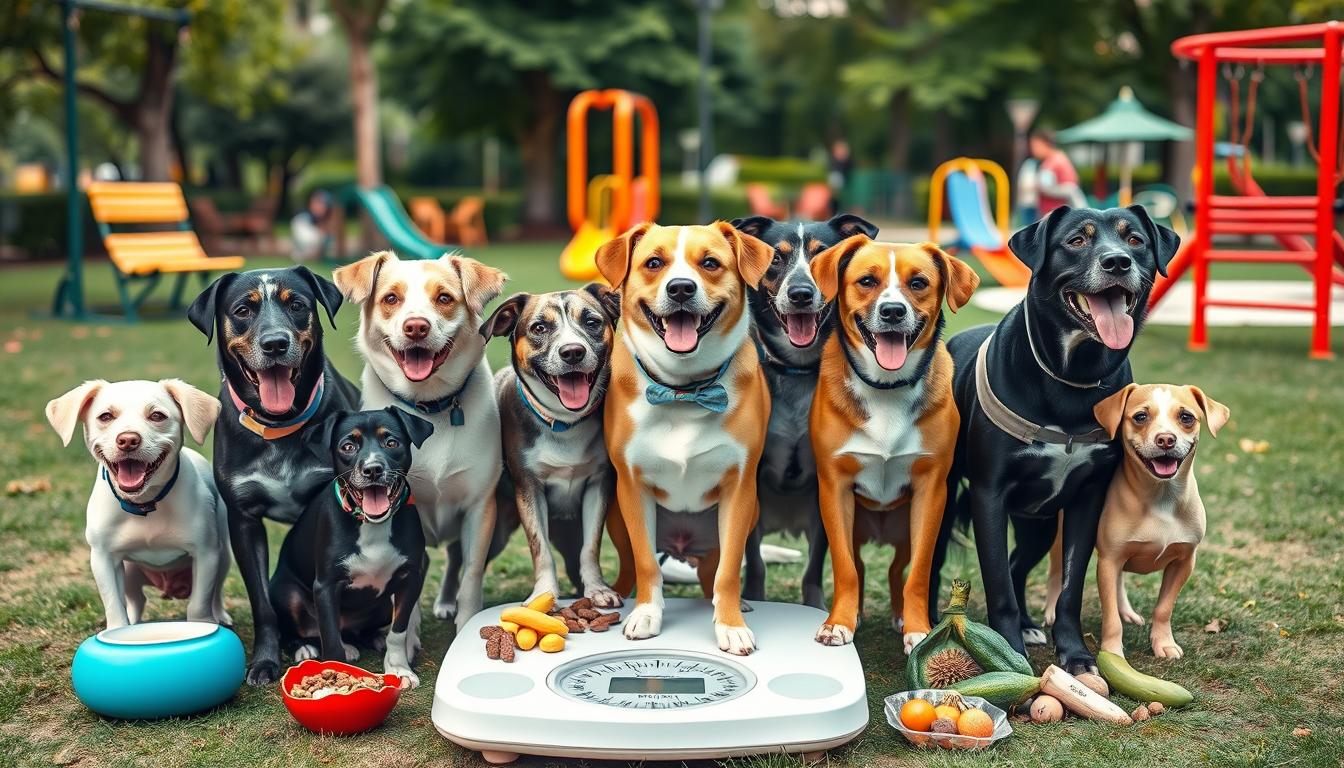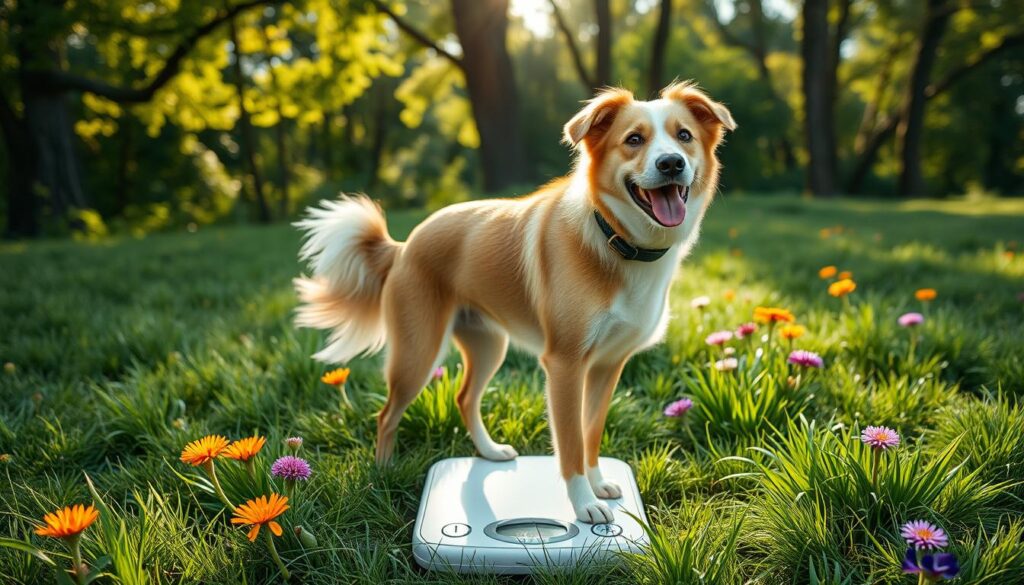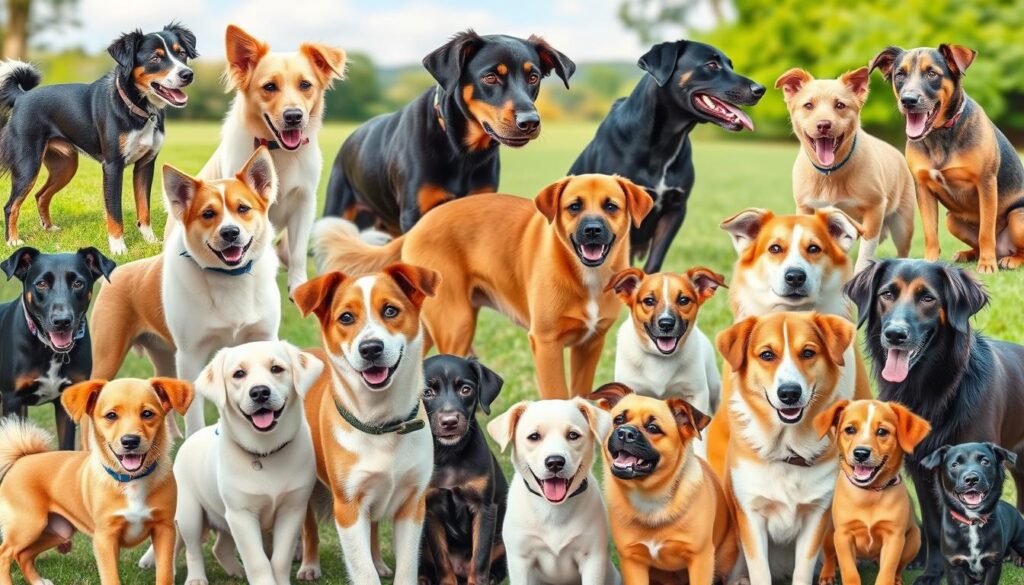Being a devoted dog parent means your pet’s health is top priority. You might wonder, “How heavy should my dog be?” Knowing this is key for their long, happy life.
When I first got my dog, I was excited to see them thrive. But finding the right weight was harder than I thought. Each breed is different, and what’s healthy for one might not be for another.
Keeping your dog at a healthy weight is vital. Too much weight can cause serious health problems like arthritis and breathing issues. On the other hand, being too thin can lead to skin and fur issues, diseases, and muscle loss. It’s crucial to regularly check your dog’s weight and body condition to keep them healthy.
Key Takeaways
- Maintaining a healthy weight is crucial for a dog’s overall health and longevity.
- Ideal weight varies among breeds and depends on factors such as size, age, and breed.
- Overweight dogs may face health issues like arthritis, back pain, and breathing problems.
- Underweight dogs can be susceptible to skin and fur problems, diseases, and muscle loss.
- Regular weight monitoring and body condition scoring are essential for keeping your dog at a healthy weight.
Understanding the Importance of Healthy Dog Weight
Keeping your dog at a healthy weight is key for their well-being. In 2022, 59% of dogs in the U.S. were overweight or obese. This extra weight can cause pain, increase cancer risk, and shorten their life.
Impact on Overall Health and Longevity
Dogs at a healthy weight can live up to two years longer. Excess weight strains their joints, organs, and heart. This makes them more likely to get diseases like osteoarthritis, diabetes, and heart disease.
Common Weight-Related Health Issues
- Osteoarthritis and joint pain
- Respiratory problems
- Diabetes
- Certain types of cancer
- Heat intolerance and increased risk of heatstroke
Quality of Life Considerations
A dog’s weight affects their quality of life. Overweight dogs may find it hard to be active. This makes their life less fun and less fulfilling. Keeping them at a healthy weight ensures they can enjoy an active and happy life.
It’s important to watch your dog’s weight and work with your vet. This helps keep them healthy and happy. By focusing on your dog’s health, you can help them live a longer, better life.
Factors Influencing Your Dog’s Ideal Weight
Several key factors determine your dog’s ideal weight. These include breed, genetics, age, and activity level. Knowing these helps keep your pet healthy and happy.
Every dog breed has a weight range. But, individual dogs can vary due to their genetics. Some breeds, like Labradors and Beagles, are more prone to obesity. Others, like Whippets and Greyhounds, tend to be leaner.
A dog’s age is also important. Puppies need more calories for growth. Senior dogs may need less as they move less.
The activity level of your dog affects their weight. Active breeds, like Border Collies, need more calories. Less active dogs need fewer calories to stay healthy.
Finding the right weight for your dog is a balance of these factors. Regular checks and a vet’s advice are key to keeping your dog at the right weight.
“Maintaining an ideal weight is crucial for a dog’s overall health and longevity. By understanding the factors that influence their weight, pet owners can make informed decisions to support their furry friends’ well-being.”
How Heavy Should My Dog Be: Breed-Specific Guidelines
Figuring out the perfect weight for your dog depends on their breed. Different breeds come in various sizes, each with its own weight range. Knowing these ranges helps keep your dog at a healthy weight.
Small Breed Weight Ranges
Small dogs like Chihuahuas, Yorkshire Terriers, and Pomeranians usually weigh between 2.3 to 3.6 kg (5 to 8 pounds). They need special care to avoid being too heavy or too light.
Medium Breed Weight Ranges
Medium-sized dogs, including Beagles, Cocker Spaniels, and Bulldogs, weigh between 9.1 to 22.7 kg (20 to 50 pounds). Keeping them at a healthy weight is key to prevent health problems.
Large Breed Weight Ranges
Large dogs, like German Shepherds, Labrador Retrievers, and Golden Retrievers, can weigh between 22.6 to 40.8 kg (50 to 90 pounds). They need the right food and exercise to stay healthy and avoid joint problems.
To find the right weight for your dog, look at breed-specific charts. Also, remember that each dog is different. Regular vet visits and checking your dog’s body condition score are important. They help keep your dog at the best weight for their health and happiness.
“Maintaining a healthy weight is not just about the number on the scale; it’s about ensuring your dog’s overall well-being and longevity.”
Understanding Body Condition Score (BCS)
Keeping your dog at a healthy weight is key for their happiness and health. The Body Condition Score (BCS) is a helpful tool for checking your dog’s weight. It uses a 9-point system to show if a dog is underweight, just right, or too heavy.
To figure out your dog’s BCS, look at them from above and the side. Also, feel their ribs, spine, and hips. A dog with an ideal BCS has a clear waistline and ribs you can feel but not see. This helps you know if your dog is too thin or too fat.
But, many pet owners don’t accurately judge their dog’s weight. They might think their dog is too heavy when they’re not, or too light when they are. This can be because of the dog’s size or other factors. That’s why it’s important to check with your vet regularly.
Keeping your dog at the right body condition is vital for their health and long life. By using the BCS for visual weight assessment, you can help your dog stay healthy and happy for years to come.
| Body Condition Score | Description |
|---|---|
| 1 (Emaciated) | Bones, spine, and hips easily visible. No fat or muscle tissue. |
| 5 (Ideal) | Ribs can be felt, but not seen. Waistline is visible when viewed from above. |
| 9 (Obese) | Bones and muscle structure hidden by fat deposits. No waistline visible. |
Popular Breed Weight Charts and Standards
Understanding your dog’s ideal weight is key. Breed-specific weight charts and standards help a lot. They show average healthy weights for different breeds, considering gender and age.
Weight Ranges for Most Common Breeds
The American Kennel Club’s database gives us a peek. A Labrador Retriever weighs 55 to 80 pounds for males and 45 to 70 pounds for females. On the other hand, a Chihuahua weighs 2 to 6 pounds, with males being heavier and females lighter.
Gender-Based Weight Differences
Male dogs are usually bigger and heavier than females, even in the same breed. This difference is important when looking at breed weight charts and standards.
Age-Related Weight Considerations
A dog’s weight changes with age. Puppies and senior dogs need different weight ranges than adults. Keeping an eye on your pet’s weight and adjusting their diet and exercise is vital for their health.
While breed weight charts and standards are useful, always talk to your vet. They can make sure your dog’s weight is just right for them.
Signs Your Dog is at an Unhealthy Weight
Keeping your dog at a healthy weight is key. Sadly, many dogs are either overweight or underweight. Knowing the signs of an unhealthy weight can help you act fast.
An overweight dog is hard to feel ribs on, has no waist, and looks rounded. In contrast, underweight dogs show their ribs, spine, and hip bones, with a sharp tummy.
It’s important to check your dog’s body condition and weight often. If you notice any changes, talk to your vet. They can tell if your dog’s weight is a problem and guide you on what to do.
| Indicator | Overweight Dog | Underweight Dog |
|---|---|---|
| Ribs | Difficult to feel | Visible |
| Waist | No visible waist | Sharply tucked abdomen |
| Appearance | Rounded | Visible spine and hip bones |
By watching for weight issues early, you can keep your dog happy and healthy for years.
The Role of Diet in Maintaining Ideal Weight
Keeping your dog at the right weight is key to their health. Diet is crucial because it affects how many calories they get and what nutrients they have. Knowing about dog nutrition helps you support their weight management.
Calculating Daily Caloric Needs
To help your dog stay healthy, figure out how many calories they need each day. This depends on their age, size, and how active they are. Your vet can help you find out how many calories are right for your dog.
Proper Portion Control
Knowing your dog’s calorie needs is just the start. You also need to control how much they eat. Too much food, even good quality, can make them gain weight. Use a measuring cup to make sure their meals are the right size.
Don’t let them eat too many treats or table scraps. These can add up and make them gain weight. Talk to your vet about the best food, how much, and when to feed your dog.
“Proper nutrition and portion control are the foundation of a healthy weight for your dog.”
Understanding diet’s role in your dog’s weight is important. A balanced diet and the right amount of calories, along with exercise, keep them happy and healthy. This ensures they stay at their best weight.
Exercise Requirements for Weight Management
Keeping dogs at a healthy weight is key to their happiness and health. The right amount and type of exercise depends on the dog’s breed, age, and health. For dogs that are overweight, it’s important to slowly increase their exercise to avoid too much strain.
Walking, playing, and swimming are great ways to help dogs burn calories and keep their muscles strong. It’s best to talk to a vet to create an exercise plan that fits your dog’s needs and goals.
Ideal Exercise Routine
- Most dogs need about 30 minutes of aerobic activity each day for health, longevity, and happiness.
- Dogs should go on 30-minute walks at least five times a week to start an exercise program, reaching an optimal duration within a structured schedule.
- The average pace of people walking with their dogs is about 25 minutes per mile, often at a sedentary slow stroll. It’s essential to maintain a brisk pace during walks to maximize the benefits.
Benefits of Regular Dog Exercise
- Helps burn calories and maintain muscle mass, contributing to effective weight loss.
- Improves cardiovascular health and overall physical activity.
- Enhances mental well-being and reduces stress for the dog.
- Strengthens the bond between the dog and its owner.
For dogs to manage their weight well, they need a balanced diet and regular exercise. Working with your vet can help you create a plan that keeps your dog at a healthy weight.
“Regular exercise is essential for maintaining a healthy weight in dogs. It’s not just about burning calories, but also about improving overall well-being and strengthening the bond between the dog and its owner.”
| Exercise Type | Recommended Duration | Frequency |
|---|---|---|
| Walks | 30 minutes | 5 times per week |
| Playtime | 30 minutes | Daily |
| Swimming | 30 minutes | 2-3 times per week |
Regular Weight Monitoring Techniques
Keeping your dog healthy means watching their weight closely. There are many ways to track your dog’s weight at home and with vet help.
At-Home Weighing Methods
At home, you can use big floor scales to weigh your dog. Or, weigh yourself with and without your dog to figure out their weight. These easy steps help you keep an eye on your dog’s weight and notice any big changes.
Professional Veterinary Assessments
Vet visits are great for checking your dog’s weight. Your vet will measure your dog’s weight and check their health. They look for any weight problems early on.
Using both at-home weighing and vet visits helps you keep a close eye on your dog’s weight. This way, you can help your dog stay healthy and happy for a long time.
“Regular weight checks are crucial for maintaining your dog’s health. A few minutes on the scale can reveal important insights about their well-being.”
Special Weight Considerations for Different Life Stages
Dogs change a lot as they grow older. Their needs for food and weight management change too. Puppies, adult dogs, and older dogs all need different things to stay healthy and at a good weight.
Puppy Weight: Puppies need lots of calories, proteins, fats, vitamins, and minerals. This helps them grow fast and strong. It’s important to watch their weight and adjust their food to keep them healthy.
Senior Dog Weight: Older dogs move less and burn fewer calories. They need food that’s not too high in calories but full of important nutrients. It’s key to check their weight and food often to keep them healthy.
Life Stage Nutrition: Pregnant and nursing dogs need special food too. They need a diet that’s full of nutrients to keep them and their babies healthy. This helps them stay at a good weight and feel their best.
| Life Stage | Key Nutritional Considerations |
|---|---|
| Puppy |
|
| Adult |
|
| Senior |
|
| Pregnant/Nursing |
|
Knowing what dogs need at different ages helps them stay healthy and at a good weight. This is important for their whole life.
Conclusion
Keeping your dog at a healthy weight is key for their health and happiness. Knowing the weight guidelines for their breed and using body condition scoring helps. This way, you can meet your dog’s needs at every stage of their life.
Watching your dog’s weight closely is important. They need the right food and enough exercise. This helps avoid health problems and keeps them lively for years to come.
Every dog is different, so what works for one might not work for another. Talk to your vet to create a plan that fits your dog’s needs. With care and commitment, your dog can live a long, happy, and healthy life.



